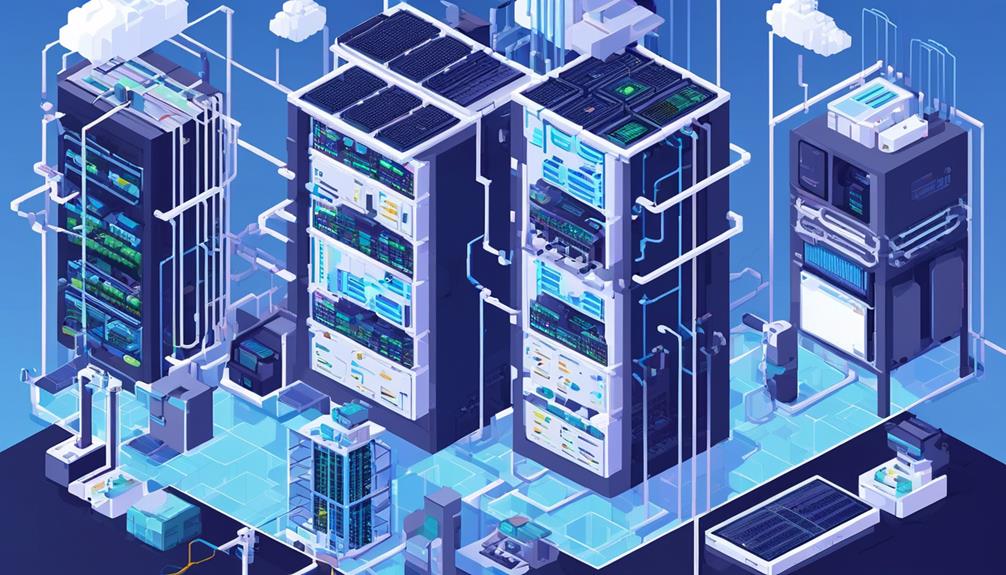With the rapid growth of data generation and the increasing demand for real-time processing, the choice between cloud computing and edge computing hardware has become a critical decision for organizations.
Cloud computing offers the advantage of centralized data storage and processing, providing scalability and cost-effectiveness.
On the other hand, edge computing brings data processing closer to the source, ensuring low latency and faster response times.
But which approach should organizations adopt?
In this discussion, we will delve into the hardware requirements, performance comparison, scalability, cost considerations, flexibility, adaptability, latency, response time, data storage, and processing capabilities of both cloud and edge computing.
By exploring these aspects, we aim to guide you towards choosing the right hardware solution for your specific computing needs.
Key Takeaways
- Cloud computing hardware requirements include robust servers, extensive storage capacities, reliable networking infrastructure, scalability, and security features.
- Edge computing hardware requirements include low power consumption, ruggedized and compact form factor, sufficient processing power, adequate memory capacity, and built-in security features.
- Edge computing provides real-time insights, bypasses latency issues, and enables efficient resource utilization.
- Cloud computing serves as the backbone of IT infrastructure, is essential for large-scale data processing, and has cost savings in maintenance and management.
Cloud Computing Hardware Requirements
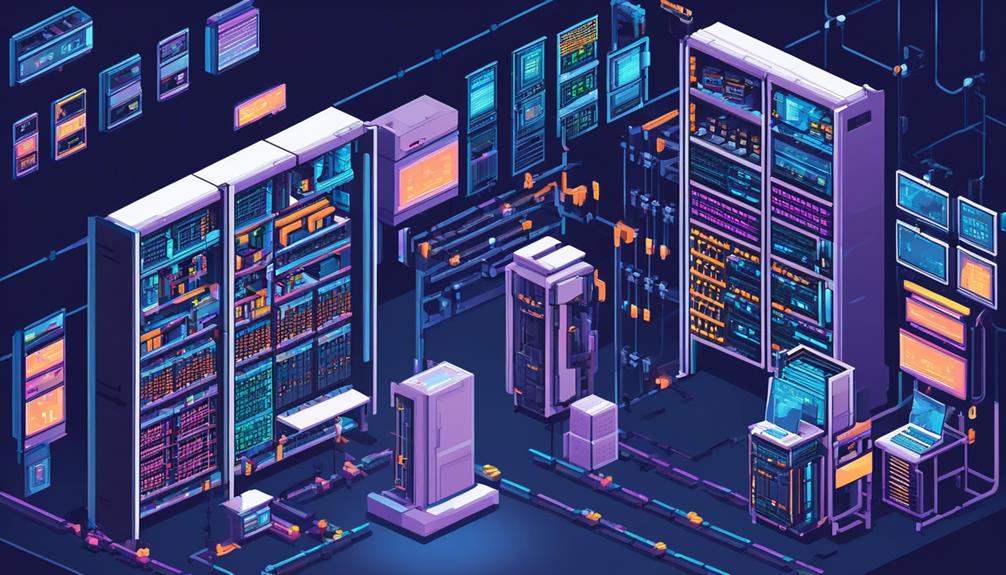
Cloud computing hardware requirements encompass the need for robust servers with high processing capabilities, extensive storage capacities, and reliable networking infrastructure to support the seamless operation of the cloud ecosystem. Powerful servers are at the heart of cloud computing, as they handle the computational tasks required for processing data and running applications. These servers are equipped with multi-core processors, large amounts of RAM, and high-speed storage devices to ensure efficient data processing and storage.
In addition to powerful servers, cloud computing hardware requires extensive storage capacities to handle the vast amount of data generated and stored in the cloud. This storage can be in the form of hard disk drives (HDDs) or solid-state drives (SSDs), depending on the specific needs of the cloud environment. Scalability is also an important factor, as cloud computing hardware should allow for easy expansion and addition of resources as the demand for cloud services grows.
Reliable networking infrastructure is crucial for connecting the servers within the cloud and ensuring seamless data transfer. High-speed switches, routers, and network cables are used to establish a robust network that can handle the large volume of data traffic in the cloud. Redundancy is also necessary to minimize downtime and ensure continuous operation. This includes redundant power supplies and cooling systems to prevent hardware failures due to power outages or overheating.
Furthermore, security features play a vital role in cloud computing hardware. Firewalls, encryption mechanisms, and intrusion detection systems are essential components to protect data and resources from unauthorized access and potential threats. These security measures help safeguard the integrity and confidentiality of the data stored and processed in the cloud.
Edge Computing Hardware Requirements
Edge computing hardware requirements encompass the need for efficient, low-power consumption devices capable of processing and analyzing data locally in remote and resource-constrained environments. Unlike cloud computing, where data is processed and stored in centralized data centers, edge computing brings computation closer to the source of data generation. This approach allows for real-time processing, reduced latency, and improved efficiency. To meet these requirements, edge computing devices must possess certain characteristics.
First, edge computing hardware should have low power consumption to operate in environments with limited resources. This allows for prolonged usage without the need for frequent recharging or power supply. Additionally, edge devices must have ruggedized and compact form factors to withstand harsh conditions and fit into constrained spaces commonly found in industrial settings or remote IoT devices.
To support local data processing and analysis, edge computing devices need to have sufficient processing power and memory capacity. This enables them to handle complex computations and perform real-time analytics without relying on cloud resources. Furthermore, these devices should have built-in security features to ensure data privacy and protection in distributed edge environments.
A table highlighting the key requirements for edge computing hardware is included below:
| Requirement | Description |
|---|---|
| Low power consumption | Devices should consume minimal power to operate in resource-constrained environments |
| Ruggedized and compact form | Hardware should be able to withstand harsh conditions and fit into limited spaces |
| Processing power | Sufficient computing power to handle complex computations and perform real-time analytics |
| Memory capacity | Adequate memory to store and process data locally, reducing the need for data transfer to the cloud |
| Built-in security features | Hardware should have security measures to protect data privacy in distributed edge environments |
Meeting these edge computing hardware requirements is essential for deploying efficient and effective edge computing solutions. By enabling local data processing and analysis, edge devices can provide real-time insights and reduce dependency on cloud resources, making them suitable for various industries and applications.
Performance Comparison: Cloud Vs. Edge Computing Hardware

When comparing the performance of cloud and edge computing hardware, three key points come to the forefront.
Firstly, the speed comparison between the two reveals the advantage of edge computing in providing real-time insights and immediate responses by processing data locally.
Secondly, the latency analysis demonstrates how edge computing can bypass latency issues by processing time-sensitive data on the edge devices themselves.
Lastly, resource utilization is a crucial aspect to consider, as edge computing enables efficient utilization of resources by processing data locally, reducing the need for constant communication with centralized data centers.
Speed Comparison: Cloud Vs Edge
In the realm of computing hardware, a comparison of speed reveals the distinct performance capabilities between cloud and edge computing.
Edge computing, with its ability to process data locally on edge devices, offers low latency and real-time insights, bypassing the delays associated with cloud computing. This makes edge computing ideal for time-sensitive data processing, where immediate responses are crucial.
On the other hand, cloud computing is better suited for non-time-driven data and serves as the backbone of organizations' IT infrastructure and data analytics. While edge computing excels in specialized and intelligent devices, cloud computing remains essential for handling large-scale data processing.
In the future, both edge and cloud computing are expected to coexist, working together to provide real-time solutions in the ever-evolving IT landscape. With its ability to handle sensitive data locally, edge computing is particularly well-suited for applications such as autonomous vehicles, industrial IoT, and real-time analytics.
Latency Analysis: Cloud Vs Edge
The analysis of latency between cloud and edge computing reveals crucial differences in performance capabilities. When comparing the two, it is important to consider the following:
- Edge computing helps bypass latency issues by processing data locally on edge devices, reducing delays in decision-making.
- Edge computing is beneficial for real-time insights and immediate responses, particularly in remote locations with limited connectivity to centralized data centers.
- Edge computing is suitable for processing time-sensitive data, while cloud computing is used for non-time-driven data.
- Edge computing is preferred in remote locations with limited connectivity and for specialized and intelligent devices.
- Edge computing and cloud computing can work together to provide real-time solutions, and both will continue to play important roles in the IT sector.
These factors highlight the importance of considering the specific requirements and limitations of each computing approach when analyzing latency performance.
Resource Utilization: Cloud Vs Edge
As we shift our focus to analyzing the resource utilization of cloud and edge computing, it becomes evident that there are distinct differences in performance capabilities between these two approaches.
Cloud computing, with its centralized data centers and remote servers, offers virtually unlimited scalability and computing power. This makes it ideal for handling large volumes of non-time-sensitive data and complex computational tasks.
On the other hand, edge computing leverages local resources on edge devices, enabling real-time processing and immediate responses. This approach is particularly beneficial for time-sensitive data processing, as it bypasses latency issues associated with sending data to a centralized location. However, edge computing has limited scalability due to its reliance on local resources.
To optimize resource utilization, organizations can adopt hybrid architectures that combine the benefits of both cloud and edge computing, managing and deploying IoT devices while providing real-time solutions.
Scalability of Cloud and Edge Computing Hardware
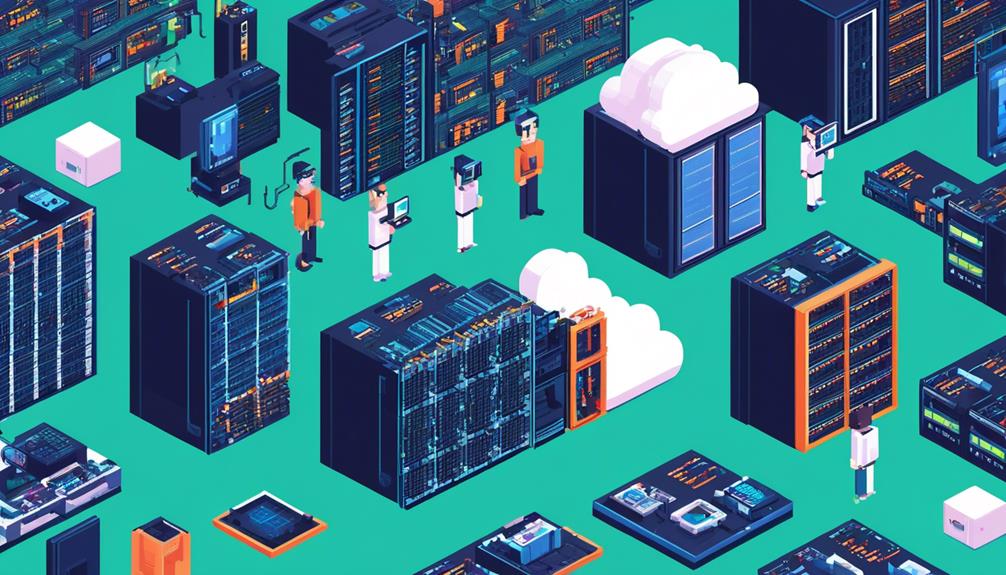
With regards to the scalability of cloud and edge computing hardware, it is important to note that edge computing offers limited scalability due to its reliance on local resources. On the other hand, cloud computing provides virtually unlimited scalability by leveraging remote servers in data centers. Here are some key points to consider:
- Edge Computing vs Cloud: Edge computing is decentralized and brings computation closer to the data source, while cloud computing centralizes resources in data centers. This fundamental difference affects the scalability of both approaches.
- Hybrid Cloud: To overcome the scalability limitations of edge computing, organizations can adopt a hybrid cloud approach. This involves combining the benefits of edge and cloud computing, allowing for the scalability of the cloud while leveraging the low latency and local processing capabilities of edge devices.
- Data Center: Cloud computing relies on data centers, which are specifically designed to handle large-scale computing and storage needs. These data centers can dynamically allocate resources to meet increasing demands, ensuring scalability for cloud-based applications.
- Cost Considerations: Cloud computing may incur higher costs for applications with high data processing and storage needs. Edge computing, on the other hand, can be more cost-effective for applications with limited data processing requirements, as it reduces the need for data transfer and storage in the cloud.
- Application Suitability: Edge computing is well-suited for applications such as autonomous vehicles, industrial IoT, and real-time analytics, where low latency and localized processing are crucial. Cloud computing, on the other hand, is commonly used for web hosting, data storage, and enterprise applications that require collaboration and data sharing across geographically dispersed teams.
Cost Considerations: Cloud Vs. Edge Computing Hardware
When comparing the costs of cloud and edge computing hardware, two key points need to be considered: cost comparison and financial implications.
Cloud computing hardware may offer cost savings in terms of maintenance and management due to centralized maintenance and updates. On the other hand, edge computing hardware may have higher initial acquisition costs and long-term operational costs, which include power consumption and maintenance at distributed locations.
Additionally, organizations should also evaluate the cost implications of data transfer and network usage between edge devices and cloud data centers.
Cost Comparison: Cloud Vs Edge
Edge computing offers a more cost-effective solution for applications with limited data processing requirements, compared to the potentially higher costs associated with cloud computing.
Here are some key points to consider in the cost comparison between cloud and edge computing:
- Cloud computing provides virtually unlimited scalability, making it ideal for applications with high data processing and storage needs, but it may incur higher costs.
- Edge computing can reduce bandwidth usage and associated costs by processing data locally, which is beneficial for applications with limited connectivity to centralized data centers.
- Cloud computing is commonly used for enterprise applications and data storage, making it a crucial component for organizations' IT infrastructure and data analytics.
- Edge computing, with its ability to address certain issues of cloud computing, is suitable for time-sensitive data processing and will continue to play an important role alongside cloud computing in the future IT landscape.
Financial Implications: Cloud Vs Edge
In assessing the financial implications of cloud computing versus edge computing, organizations must carefully consider the cost considerations associated with the hardware involved in each approach. Edge computing hardware often requires higher upfront costs compared to cloud computing due to the need for specialized equipment at distributed locations. On the other hand, cloud computing hardware can lead to lower ongoing maintenance costs as hardware upkeep and upgrades are managed by the cloud provider. Cloud computing also offers cost savings in terms of scalability, as resources can be allocated and de-allocated based on demand. In contrast, edge computing may require over-provisioning hardware to handle peak workloads. Additionally, edge computing hardware can result in reduced data transfer costs as data processing and analysis occur closer to the source. Overall, organizations should factor in the total cost of ownership, including hardware, maintenance, data transfer, and scalability, to determine the most cost-effective approach for their specific use cases.
| Cost Considerations | Cloud Computing | Edge Computing |
|---|---|---|
| Upfront Costs | Lower | Higher |
| Ongoing Maintenance | Lower | Higher |
| Scalability | Cost-effective | Over-provisioning may be required |
| Data Transfer Costs | Higher | Lower |
Security Features of Cloud and Edge Computing Hardware
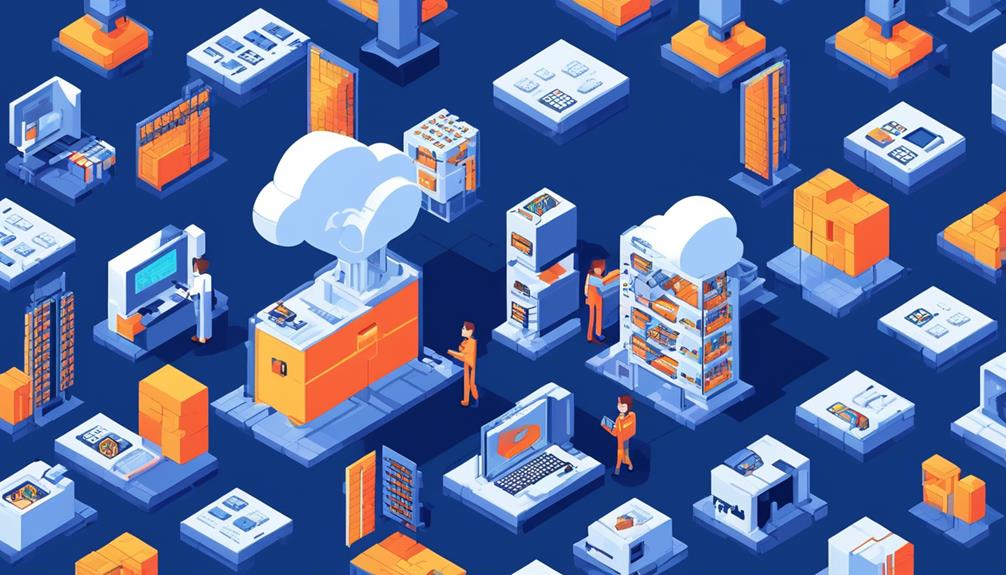
Cloud and edge computing hardware exhibit robust security features, including data encryption, secure access controls, and compliance certifications, to safeguard sensitive information. These security measures are crucial in protecting the integrity and confidentiality of data in the era of IoT and edge computing. Here are the key security features offered by both cloud and edge computing hardware:
- Data encryption: Both cloud and edge computing hardware employ encryption techniques to scramble data, making it unreadable to unauthorized parties. This ensures that even if data is intercepted, it remains protected.
- Secure access controls: Cloud and edge computing hardware implement access controls, such as strong authentication mechanisms and role-based access controls, to ensure that only authorized users can access sensitive data and resources.
- Compliance certifications: Cloud and edge computing hardware adhere to industry-specific compliance standards, such as ISO 27001 and HIPAA, ensuring that they meet the necessary security requirements and regulations.
- Tamper-resistant hardware: Edge computing hardware incorporates tamper-resistant hardware components, making it difficult for attackers to tamper with or manipulate the device. This provides an additional layer of security for edge devices located in remote or unsecured environments.
- Secure communication channels: Both cloud and edge computing hardware establish secure communication channels, leveraging protocols like SSL/TLS and VPNs, to protect data transmission between devices, networks, and cloud platforms.
These security features demonstrate the commitment of cloud and edge computing hardware to mitigating potential security risks and safeguarding sensitive information. As the threat landscape evolves, these security features continue to evolve as well, offering a multi-layered defense approach against vulnerabilities and attacks.
Flexibility and Adaptability: Cloud Vs. Edge Computing Hardware
Flexibility and adaptability are key differentiators between cloud and edge computing hardware.
While cloud computing offers scalability by allowing organizations to easily expand their resources as needed, edge computing provides the flexibility to process data locally on edge devices, enabling real-time insights and immediate responses.
Additionally, edge computing is adaptable for specialized and intelligent devices in remote locations with limited connectivity, while cloud computing remains crucial for organizations' IT infrastructure and data analytics.
Both paradigms will coexist in the future, providing real-time solutions and managing and deploying IoT devices.
Scalability Differences
Edge computing hardware offers a level of scalability that is tailored to applications with limited data processing requirements, making it a cost-effective solution for those specific needs.
However, when comparing scalability differences between cloud and edge computing hardware, it is important to consider the following:
- Cloud computing hardware provides virtually unlimited resources for applications with high data processing and storage needs.
- Edge computing hardware has limited scalability due to its reliance on local resources.
- Cloud computing hardware can be cost-effective for applications with high data processing and storage needs, leveraging remote servers and centralized network infrastructure.
- Edge computing hardware is well-suited for applications like autonomous vehicles, industrial IoT, and real-time analytics.
- Cloud computing hardware is commonly used for web hosting, data storage, and enterprise applications.
These differences in scalability highlight the unique strengths and limitations of both cloud and edge computing hardware in meeting various application requirements.
Latency and Response Time
When considering the differences in scalability between cloud and edge computing hardware, it is important to examine the impact of latency and response time on the flexibility and adaptability of these technologies. Edge computing helps bypass latency issues by processing data locally on edge devices, providing immediate responses. This is particularly useful in remote locations with limited or no connectivity to centralized data centers. Edge computing can provide real-time insights and immediate responses, making it suitable for time-sensitive data. On the other hand, cloud computing is used for non-time-driven data and remains crucial for organizations' IT infrastructure and data analytics. Edge computing is beneficial for specialized and intelligent devices and is preferred in remote locations with limited connectivity.
| Cloud Computing | Edge Computing |
|---|---|
| Non-time-driven data | Time-sensitive data |
| Centralized data centers | Local processing on edge devices |
| Suitable for data analytics | Real-time insights and immediate responses |
Latency and Response Time: Cloud Vs. Edge Computing Hardware
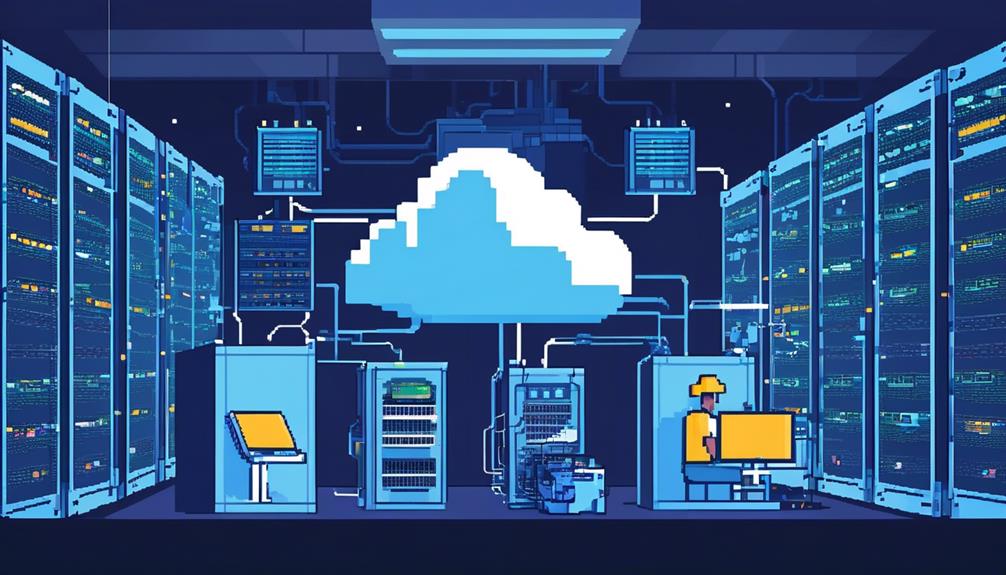
Latency and response time greatly differ between cloud and edge computing hardware. Edge computing offers significantly lower response times due to its local data processing capabilities.
Here are five key points to consider when comparing the latency and response time of cloud and edge computing:
- Edge computing helps bypass latency issues by processing data locally on edge devices. This eliminates the need to send data back and forth to a centralized cloud server, resulting in faster response times.
- Time-sensitive applications, such as real-time monitoring or autonomous systems, can benefit greatly from edge computing. Immediate responses are crucial for operational efficiency, and edge computing enables faster decision-making and action.
- Smart devices with computation power placed on the edge of the network can monitor and respond to predefined metrics. This localized processing allows for quicker reactions to changing conditions, reducing latency and enhancing the overall user experience.
- Edge computing provides real-time insights and immediate responses. This makes it suitable for applications that require fast reaction times, such as emergency response systems or high-frequency trading.
- In remote locations with limited or no connectivity to centralized data centers, edge computing is particularly valuable. Cloud-based solutions may not be feasible due to latency issues, but edge computing can still offer local data processing and fast response times.
Data Storage and Processing Capabilities: Cloud Vs. Edge Computing Hardware
Data storage and processing capabilities differ between cloud and edge computing hardware, with each offering unique advantages in the realm of data management and analysis.
Edge computing involves local data storage and processing capabilities, allowing for real-time insights and immediate responses. This is achieved by deploying intelligent devices, or edge devices, closer to the data generation source. These devices have the ability to process and analyze data locally, eliminating the need to send it to centralized data centers.
On the other hand, cloud computing relies on centralized data centers for storing and processing data. This approach is suitable for non-time-sensitive data processing and allows for scalability and flexibility. Organizations can leverage cloud infrastructure to efficiently manage and analyze large volumes of data.
Edge computing is particularly beneficial in remote locations with limited connectivity. By processing data locally, edge devices can operate even when there is no internet connection, ensuring uninterrupted performance. Additionally, edge computing is well-suited for specialized devices that require low latency and immediate responses, such as autonomous vehicles or industrial machinery.
However, cloud computing remains crucial for organizations' IT infrastructure, data analytics, and managing and deploying IoT devices. Cloud data centers offer vast storage capacities and high processing power, making them ideal for handling large-scale data processing and analytics tasks.
Choosing the Right Hardware for Your Computing Needs
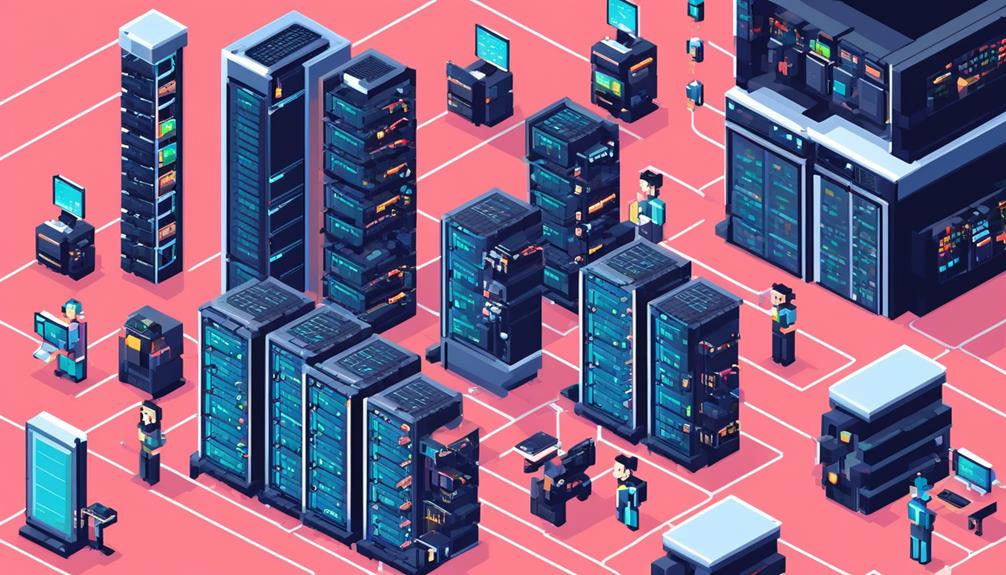
To ensure optimal performance and efficiency, selecting the appropriate hardware for your computing needs requires careful consideration of factors such as processing and storage requirements, real-time processing needs, connectivity and network infrastructure, scalability and cost implications, as well as security and privacy concerns.
When choosing the right hardware for your computing needs, it's essential to evaluate whether edge devices or centralized cloud servers are more suitable based on the processing and storage requirements of your workload. Edge computing allows for local processing and storage, while cloud computing offers vast storage capabilities and powerful processing capabilities.
Another factor to consider is the real-time processing needs of your applications. Edge computing, with its low latency capabilities, may be a better fit if your applications require immediate and real-time processing. On the other hand, cloud computing may be more suitable for applications that can tolerate slight delays in processing.
Connectivity and network infrastructure also play a crucial role in hardware selection. Edge computing can operate independently of the internet, making it a practical choice for locations with limited connectivity or unstable network infrastructure. In contrast, cloud computing relies on a stable internet connection for data processing and storage.
Scalability and cost implications are significant considerations as well. Edge computing has limited scalability compared to the virtually unlimited scalability of cloud computing. Depending on your long-term needs and budget, you must decide which option aligns better with your requirements.
Frequently Asked Questions
What Is the Difference Between Cloud and Edge Devices?
The difference between cloud and edge devices lies in their location and functionality.
Cloud devices are centralized data centers that store and process data, while edge devices are situated closer to the data source for real-time processing.
Cloud devices offer scalability and cost-effectiveness, while edge devices provide low latency and immediate response capabilities.
Their use cases vary depending on the specific requirements of the data and the environment.
In the future, both cloud and edge computing will continue to coexist, serving different purposes in the IT landscape.
Is Edge Computing Better Than Cloud Computing?
Edge computing and cloud computing are two distinct technologies with their own advantages and use cases.
Edge computing offers real-time processing and low latency, making it ideal for time-sensitive data and specialized devices. It excels in remote locations with limited connectivity.
However, edge computing faces challenges in terms of scalability, security, and maintenance compared to cloud computing.
Ultimately, it is not a matter of one being better than the other, as both play critical roles in the IT sector and complement each other in various scenarios.
What Is the Difference Between Edge Core and Cloud?
Edge core refers to the processing capabilities of edge devices, which enable them to perform computations locally, closer to the data source.
On the other hand, cloud computing involves the use of centralized data centers for storing and processing data. The difference lies in the location of processing: edge devices perform computations at the edge, while cloud computing relies on remote servers.
This distinction is crucial in understanding the advantages and trade-offs between edge computing and cloud computing.
What Is Edge Computing Hardware?
Edge computing hardware refers to the physical devices and infrastructure used in edge computing architecture. These devices are designed to process and analyze data locally on the edge, closer to the source of data generation. They include edge computing devices such as edge servers, gateways, routers, and sensors.
Edge computing hardware enables real-time data processing, reducing latency and enhancing performance. It finds applications in various domains, including industrial automation, healthcare, transportation, and smart cities, where immediate insights and rapid decision-making are crucial.
